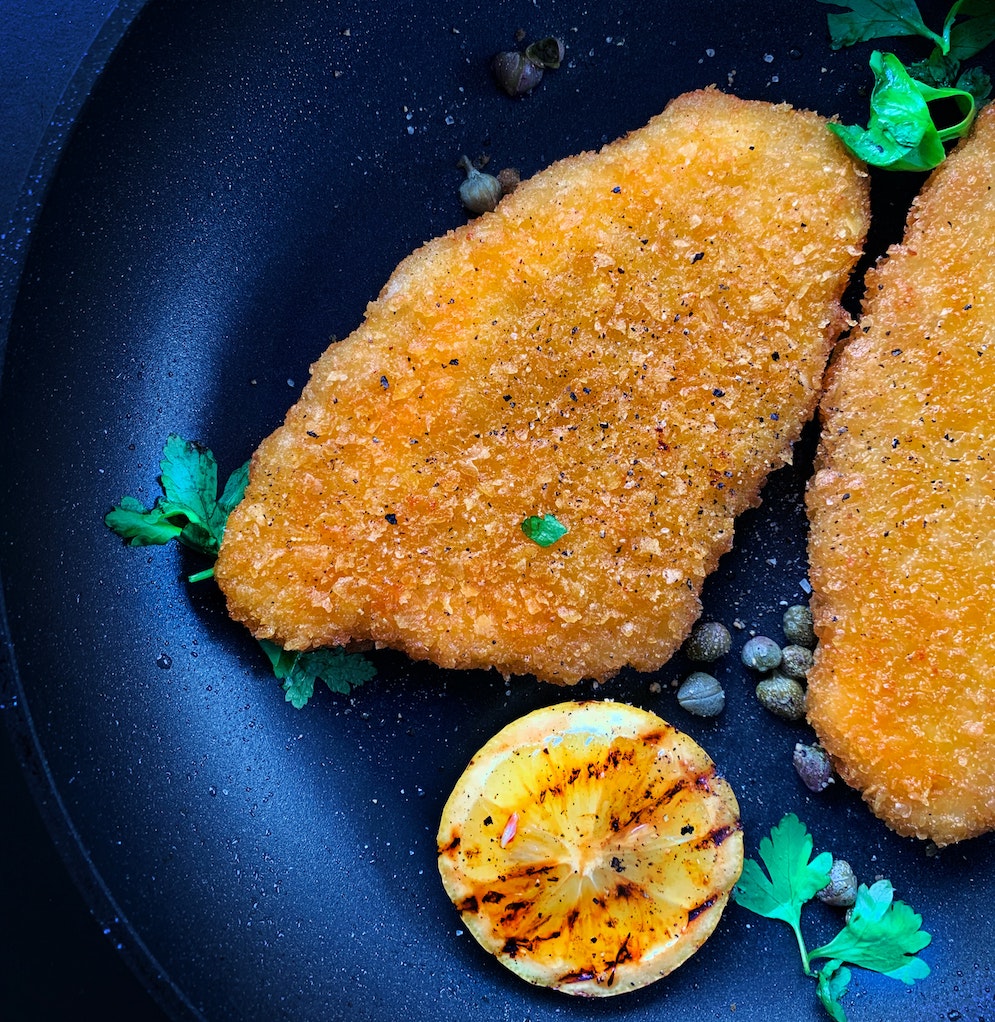What’s the ultimate Milanesa recipe? That depends on where you are in Argentina, or maybe Uruguay, as each region has their own twist on the classic milanesa recipe. Clorrie Yeomans looks at one of South America’s great comfort foods and wines to pair it with.
Celebrating the Argentine milanesa
Argentina is renowned for its juicy steaks and asados. However, this South American country has another unofficial national dish: the milanesa. Imagine a thin slice of beef, chicken, pork, veal or fish in breadcrumbs – crispy on the outside yet tender and succulent on the inside. This humble yet delicious dish is the ultimate comfort food. It is such a favourite among Argentines that National Milanesa Day is celebrated every 3rd May!
However, the origins of this dish can be traced all the way back to Austria. It is believed that after the conquest of the Austro-Hungarian empire, the schnitzel was brought to Milan, where it became known as the cotoletta alla milanese.
This dish was then brought to the Southern Cone by the great waves of Italian immigrants who settled in the Americas (especially in Uruguay and Argentina) during the late nineteenth and early twentieth centuries. As a result, the customs, language and cuisine of these immigrant communities, the Italian diaspora, became syncretised with those of the local population.
The humble milanesa, as it became known in Spanish, is the perfect embodiment of how the Italian influences became an accepted and celebrated part of national identity in many Latin American countries.
Latin American milanesas & regional milanesa recipes
What really brings this simple yet versatile dish together are the different toppings which express the diverse cuisines throughout the continent. In the northern states of Mexico, the milanesa is served with refried beans, chips, rice and a local salad.
Whereas in Paraguay and Uruguay, milanesa a caballo (literally ‘milanesa on horseback’) is a classic- served with a fried egg on top without the tomato sauce. The Chilean milanesa kaiser is very similar to the Swiss Cordon Bleu- a layer of melted cheese and a slice of ham is placed in between the cut of breaded meat. While the escalopa a lo pobre is topped with french fries, sauteed onions and fried egg. In Panama, milanesas are served with a squeeze of zingy lime juice and hot sauce and side dishes such as rice, lentils and beans.
The gourmet milanesa a la napolitana is perhaps the most popular variety on restaurant menus in Argentina. Surprisingly, the name napolitana has nothing to do with the city of Naples. The dish is in fact named after the Restaurante Napoli owned by Jorge La Grotta in Buenos Aires during the 1940s.
The creation of this Argentinean favourite was actually a culinary mistake. One night, when the chef was preparing the milanesa for a customer, he accidentally burnt the piece of meat. In an effort to conceal the burnt milanesa, the quick-thinking manager, Jorge La Grotta, covered the meat with tomato sauce, ham and melted cheese. He then presented the milanesa to his customer as the restaurant’s new culinary invention. The customer was very satisfied by his food and soon, the neighbouring restaurants started to prepare the dish which became known as the milanesa a la napolitana or suprema a la napolitana when prepared with chicken.
With vegetarianism and veganism on the rise in Argentina, you’ll now find aubergine, cheese and soya milanesas are popular options on restaurant menus. In Argentina and Uruguay, the most common side dishes for milanesas are chips, salad and cheesy mashed potatoes (known as ‘milanesa con pure’).
If you have any leftovers, cold milanesas are delicious in a sandwich, known as the emparedado de milanesa, which is a popular on-the-go food among porteños. Although you’ll find milanesas on most restaurant menus, many Argentineans would agree that nothing can beat a homemade milanesa made by their mother or grandmother.
It’s never hard to find breaded milanesas which are ready to cook, as they are on sale in most carnicerias (butchers). But why not try making your own delicious milanesa from scratch with our classic milanesa recipe?
The ultimate milanesa recipe
Ingredients:
- Main ingredient (chicken, beef and aubergine are most common)
- Breadcrumbs
- Egg
- Salt & Pepper
- Chopped parsley and garlic, to taste
Step One:
Prepare the protein. If you’re making meat milanesas, choose a thin cutlet of meat with very little fat. Remove any remaining fat or sinew- this is what will help the meat to curl up at the edges and crispen up. You could also use chicken breast, or sliced aubergine or sweet potato.
Step Two:
Place the meat on a piece of greaseproof paper (papel manteca in Spanish) and pound it with a mallet until it is about half a centimetre thick. If you are making a vegetarian milanesa, simply slice your vegetables a centimetre thick.
Step Three:
Dip the meat or veg in a mixture of beaten eggs, chopped parsley, salt, pepper and chopped garlic ( can be adapted to taste, for example, by adding oregano or paprika).
Step Four:
Cover the meat in breadcrumbs. You can experiment with your breadcrumb mixture by adding parmesan or sunflower seeds, sesame seeds or oats as a healthy option.
Step Five:
It’s cooking time! Shallow fry your milanesas until they are crispy on the outside, yet succulent and tender on the inside (‘fritura profunda’ in Spanish). The key is to make sure your oil is nice and hot and to add just the right amount of oil to crispen up the outside layer but not too much- as the milanesa will absorb it all.
For a tasty and healthier option, you can drizzle some olive oil onto a baking tray and simply bake your milanesas in the oven.
After cooking, place milanesas onto a plate and pat with kitchen towel to absorb any excess oil.
Step Six:
Time to add the toppings! You can be as classic or creative as you like. Here’s some suggestions, which you add onto the cooked milanesas:
- Squeeze of lemon juice- this simple twist cuts through the oil and adds a touch of freshness and acidity which works really well with both chicken and fish milanesas.
- Caprese – add tomato sauce and mozzarella. Place under the grill until the cheese is melted. Sprinkle some fresh basil on top to serve.
- Napolitana – tomato sauce, slice of ham and melted mozzarella
- Mozzarella, ham and olives
- A caballo – fried egg on top
- Melted roquefort
- Olive tapenade and rocket
- Melted cheddar cheese and red onion
- Barbeque sauce
- Cuatro quesos (four cheese) – experiment with your cheeses – parmesan, mozzarella and cheddar are all tasty options.
- Brie and cranberry sauce
- Hawaiian – mozzarella, ham and pineapple
- Sundried tomatoes, mozzarella and rocket
- Mexicana – guacamole, sour cream, salsa and cheese
- Goat’s cheese and caramelised red onion
Step Seven:
Now pour yourself a large glass of wine (if you haven’t already) and dig in!
Milanesa wine pairings
What wine you pair with a milanesa really depends on your choice of toppings and ingredients. With a classic beef milanesa, I like to pair it with a juicy Malbec wine. Although if I’m adding roquefort or other cheesy toppings, I enjoy it with a Tannat, Cabernet Sauvignon or red blend.
For chicken milanesas, I’m fond of light red wines such as Cabernet Franc from Argentina, or Pinot Noir, or with a bold white wine blend or Chardonnay.
For vegetarian milanesas, it all depends on the topping too – although sweet potato milanesas with goat’s cheese and red onion pairs wonderfully with coastal Sauvignon Blanc!
What are your favourite milanesa recipes, variations and pairings? Let us know in the comments.

